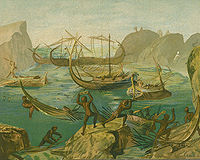Laistrygons
The Laistrygones (Latin Laestrygones) are mentioned in Homer , Ovid , Hyginus and Apollodor . They are a fairytale-like people of giants and cannibals who only breed cattle but not farm and are described as extremely uncivilized. The progenitor of the Laistrygons is Laistrygon , a son of Poseidon and Gaia .
Odysseus arrives on the seventh day after visiting the island of Aiolos and before visiting Kirke on the island of Aiaia . He loses a large part of his crew and his ships here because he is attacked by the Laistrygones.
The son of Poseidon Lamos is named as a king of the Laistrygons . His descendant Antiphates is also given as a king, whose daughter meets the three scouts of Odysseus at the Artakie spring . Antiphates has a scout of Odysseus served as a "feast", the other two manage to escape.
Odysseus was able to escape with a small number of his companions on his ship, as he was the only one who did not let it go into port; the rest of his men are devoured by the laistrygons.
The capital of the Laistrygones is called Telepylos (distant gate), probably named after the port with a narrow entrance. Some authors have suggested that Telepylos means "distant Pylos", in contrast to (nearby) Pylos in the Peloponnese.
The situation of the land of the Laistrygones is uncertain. Homer mentions that the day and night paths are near there, which is why a shepherd who does not sleep can earn double wages - as a shepherd and as a cattle herder.
The later Greeks sought the residence of the Laistrygones in Sicily , especially below Mount Etna in the fields of the city of Leontinoi , the Roman authors on the southernmost coast of Latium in the area of Formiae . A place near Kyzikos on the Marmara Sea is also being considered, since the Argonauts legend also mentions a source there called Artakie and the counter-ice living there reveals certain parallels to the Laistrygons. Others have identified Mezapos near Stavri in the Peloponnese in Greece as a location. After carefully weighing the above-mentioned places (Leontinoi / Formiae), Ernle Bradford comes to the conclusion that it is (the port of) Bonifacio . Armin Wolf, on the other hand, locates the Laistrygones in western Sicily, on the Gulf north of Marsala .
literature
- Hubert Cancik , Helmuth Schneider (ed.): The new Pauly . Encyclopedia of Antiquity . Volume 6. Metzler, Weimar and Stuttgart 1999, ISBN 3-476-01476-2
- Hans von Geisau : Laistrygones. In: The Little Pauly (KlP). Volume 3, Stuttgart 1969, column 457 f.
- Ernle Bradford: Traveling with Odysseus. Among the most beautiful islands, coasts and sites of the Mediterranean ( Ulysses found , 1963). New edition Insel-Verlag, Frankfurt / M. 1999, ISBN 3-458-34208-7 (former title: Traveling with Homer ).
- Otto Jessen : Laistrygones . In: Wilhelm Heinrich Roscher (Hrsg.): Detailed lexicon of Greek and Roman mythology . Volume 2.2, Leipzig 1897, Sp. 1809-1811 ( digitized version ).
Remarks
- ↑ Homer, Odyssey 10, 80-132.
- ↑ Ovid, Metamorphosen 14, 233-242
- ^ Hyginus, Fabulae 125
- ↑ Library of Apollodorus , Epitome 7,12
- ↑ Albert Gruhn : The scene of the Iliad and Odyssey, volumes 9-11. 1910, p. 34. Similarly, Armin Wolf : Homer's journey. In the footsteps of Odysseus. Böhlau-Verlag Köln, 2009, ISBN 978-3412204075 , p. 51, which refers to pronounced geographical similarities between the Messenian Pylos on the Bay of Navarino (which he equates with the Homeric Pylos) with the Bay of Marsala , where he suspects Telepylos (ibid, p. 44ff.).
- ↑ Homer, Odyssey 10, 83-86.
- ↑ Thucydides 6: 2; Theopompus in Polybios 8, 9, 13.
- ↑ Strabo 1, 2, 9; Eustathios , Commentary on Homer, Odyssey 10, 81, p. 1649, 10; Scholion of Lycophron , Alexandra 662.
- ↑ Cicero , Epistulae ad Atticum 2, 13, 2; Pliny the Elder , Naturalis historia 3, 59.
- ↑ cf. on this Uvo Hölscher : The Odyssey. Epic between fairy tale and novel. CH Beck, Munich 2000, pp. 171-173.
- ^ Ernle Bradford: Traveling with Homer. The recovered islands, coasts and seas of the Odyssey. dtv Munich 1967.
- ↑ Armin Wolf: Homer's Journey. In the footsteps of Odysseus. Böhlau-Verlag Cologne, 2009, ISBN 978-3412204075 , p. 44 ff.
